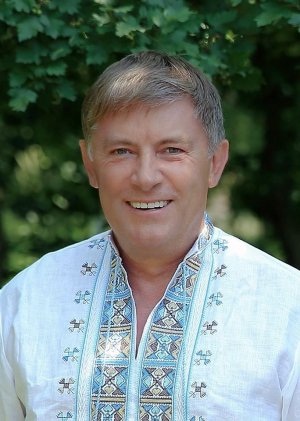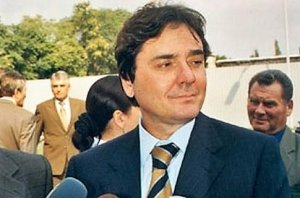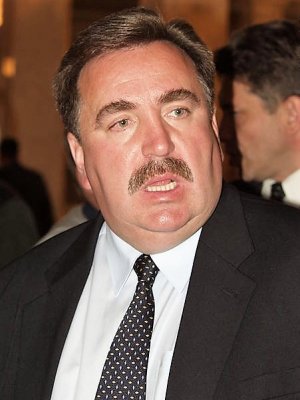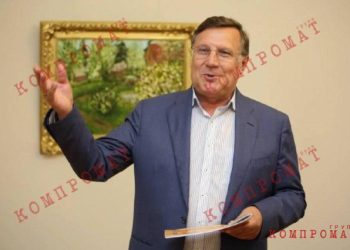Fedor Shpig. The same Fedya is the Ukrainian banking genius and dairy king. PART 1
Fedor Shpig is an honored milkman and banker of Ukraine. He created two banks from scratch, sold them at a dizzying price to foreign investors and invested the money in “milk” rivers. Needless to say, Shpig now lives on the “muslin” shores – he owns expensive cars, the most popular brands of dairy products in the country – TM Yagotynskoye, Slaviya, Molochny Shlyakh, opens grain terminals and cinemas.
He talks about how to make money out of thin air and ride the milk wave. Skelet.Info.
Fedor Shpig. Lenin raised us
Fedor Ivanovich Shpig was born on January 30, 1956 in the “Bukovinian community” – in the village of Kobyzhcha, Chernihiv region. The future dairy magnate comes from a simple family. His father, Shpig Ivan Filippovich, worked on the railway, and his mother, Litvin Maria Grigorievna, worked on a collective farm. In his rare interviews, Shpig admitted that he was fond of football as a child. He played in a yard team, and even went with it to the largest all-Union football competition, “Leather Ball”. Note that these competitions ceased to exist in 1986. As soon as Fyodor Ivanovich became a people’s deputy, in 1998, with his participation, an amateur league of the all-Ukrainian club “Leather Ball” was created.

Alexander Derkach
In 1976, Shpig received secondary education, graduating from the Kiev Shipbuilding College with a degree in design technician. After this, he was immediately drafted into the army, and for two years the young man repaid his debt to his homeland. Returning home, the guy got his first job at the Leninskaya Kuznitsa Central Design Bureau. After working at the enterprise for only a year, he moved to the Brovarymebel association as a design engineer.
In the early 80s, a young and promising designer moved along the party line, zealously promoting the ideas of Leninism. In 1982, he began managing the affairs of the Central Committee of the Leninist Young Communist League. During his Komsomol work, two fateful meetings took place in the life of Fyodor Ivanovich – with his current business partner Alexander Derkach, who since 1982 worked as the first secretary of the Kyiv regional committee of the Komsomol; and with Pyotr Miroshnikov, head of the sector of the Republican headquarters of student detachments, the future founder of the “banking movement” of independent Ukraine.

Petr Miroshnikov
The men occasionally crossed paths with each other, but did not communicate much. However, as further developments show, they were all waiting for the collapse of the USSR in order to start their own business and get rich in the open air. But more on that later.
Before joining the banking system, party member Shpig received a diploma in economics from the Kyiv Institute of National Economy. Later he defended his thesis “Managing the activities of a commercial bank.”
How the “party gold” was laundered
In 1989, at a meeting of the Supreme Soviet of the USSR, the issue of liquidating the State Bank of the USSR was discussed. A day later, the deputy chairman of the State Bank signed a decision to terminate the existence of the financial institution. Meanwhile, cunning party workers “became friends” with Moscow businessman Vladimir Vinogradov, who at that time was the head of Inkombank. Marxist-Leninists, without thinking twice, suggested that Vinogradov create a branch of a Russian bank in Kyiv. This is how the Innovative Commercial Bank Inkombank appeared in Ukraine. The first non-state bank was headed by yesterday’s Komsomol apparatchik Pyotr Miroshnikov.
After some time, the Ukrainian branch decided to spin off. This happened surprisingly painlessly: Inkombank received its share in the newly created Inko, and Miroshnikov and Vinogradov remained friends. The question hung in the air: where did a simple Komsomol member get the money to open his own bank? Officially: the shareholders of the new bank (the Vulcan plant, the Rotor association, the Atek excavator plant, Azovstal, the Academy of Sciences of Ukraine and the Nezavisimost newspaper) made their contribution to the authorized capital, Miroshnikov himself owned only 3%. Unofficially, as it became known Skelet.Info: the money was given by high-ranking employees of the CPSU Central Committee apparatus, it was the so-called “party gold”, which was then searched for a long time, both abroad and throughout the Soviet Union.
“Inko” was officially located at Kyiv, Nizhneyurkovskaya street, 81, but in fact – in two or three rooms of the State Statistics Committee building. There was a piece of paper with the name of the financial institution hanging on the front door. The first room served as a dressing room and a wardrobe with chairs for things, while the second room housed employees. They were far from progressive Moscow bankers. They were distinguished by the Komsomol style – black suits with fitted jackets and tapered trousers. The address of the bank clerks was also confusing: “Who are you seeing, comrade?…”. I was also struck by the mystery of a commercial transaction – the clerk studied the payment slip, made a note, and then simply put a stamp. In this dubious office, which in the future became a huge “soap bubble,” Pyotr Miroshnikov invited “that same” Fedya to work. Since 1991, Fedor Shpig became a key figure in the central office of the bank – head of the credit resources department. Simply put, he personally distributed loans. Some “one-day” people received money from Fyodor Ivanovich. According to information Skelet.Infoafter issuing the first (!) loan, Shpig bought himself a “six” – a brand new VAZ 2106 (for a Soviet person it was like buying a Porsche now), and some time later he made a chic one in his metropolitan apartment in Pechersk on Lesi Ukrainki Boulevard, 9B repair. Later, the banker will have other cars, a luxurious dacha, and even his own Aval bank. He secretly put the money received from loans and kickbacks into a little box.
The period of rapid development of Inko occurred during the presidency of Leonid Kravchuk, when Komsomol connections were in favor and there was no competition. The bank was even allowed to serve powerful government agencies, and was also regularly “fed” with preferential loans from the National Bank. For example: in 1992, Inko had 17 branches, then in 1994 – already about 60. Surprisingly, the authorized capital of the bank amounted to billions of karbovanets. For a post-Soviet person, these were mountains of money, but in fact, in dollars, this is cash at the average exchange office in a peripheral town in Europe. But the most surprising thing is that people trusted Inko, which famously gave loans to everyone, indiscriminately. Perhaps they believed in the all-powerful CPSU, whose “death” they did not take seriously. Also, many former party workers transferred money to the financial structure on instructions from above.
Fedor Shpig. Cans on a conveyor belt
“Aval”. Fyodor Shpig could not sit in the shade for a long time. Moreover, he had a large amount of money in his hands from credited clients. And then luck took over. In 1992, Pyotr Miroshnikov began developing a large project to transfer the Pension Fund accounts to his bank. At a certain stage, a separate institution was created for it – “Aval”. Initially, 90% of the shares of the new structure belonged to Inco, the remaining to the Pension Fund. Miroshnikov gave the reins of Aval to Fedor Ivanovich. And he took and bought the shares, and also transferred a certain amount of “Inca” money to his brainchild.
Shpig invited a man from his past life, Alexander Derkach, to work, and gave him the position of Chairman of the Bank’s Board. The financial institution joined the Association of Ukrainian Banks, but it worked with difficulty. After 2 years, Fyodor Ivanovich decides on a radical reorientation and creates the Aval postal pension bank. The responsibilities of the structure included the “gold mine” – servicing the Pension Fund and the Ukrainian Post, and soon, the Ministry of Internal Affairs and customs. This opened the way to huge sources of monetary resources. Billions of hryvnia began to pass through the bank’s accounts, lending with which in the 90s it was possible to receive fabulous income – loan rates often exceeded 50-60% per annum. The authorized capital of Aval soared to a record 5 billion rubles. This begs a logical question: why did officials “stretch” the average bank of Fedor Shpig to such heights? According to the official version, in the 1990s there were no other financial institutions except Aval, which could serve large enterprises and drain money. However, there is a second version. According to information Skelet.InfoSpy was helped by the odious corrupt official Pavel Lazarenko. There are papers personally signed by Prime Minister Lazarenko, which ordered state-owned enterprises to switch to services at Aval. An interesting fact: after Lazarenko fled the country, the bank’s business went uphill.
The fame of “Aval” spread in a matter of months – large salaries, bonuses, financial assistance, trips to resorts, but the work was hard – in the “fields”, attracting clients and concluding contracts. However, it brought together the best managers of the region: in 1994 he came to work here Yakov Smoliytoday’s acting head of the National Bank; in 1995 – Andrey Rozhok, holding the post of Chairman of the Board of Prominvestbank PJSC; and in 2001, Arseniy Yatsenyuk, ex-Prime Minister of Ukraine. By the way, Arseny Petrovich owes his career exclusively to Shpig, who brought him into the public eye.
During the financial crisis in the late 90s, Shpig and Derkach not only kept Aval afloat, but also pulled it into leadership. In 1999, the bank took second place in the category “Bank where you would place a deposit.” It is worth noting that there were no educated financiers or managers in the institution; all operations were carried out at random.
In 2004, after the Orange Revolution, a crisis began in the country. Ukrainians rushed to banks to withdraw their money. “Aval” also suffered from the “raids”. In a matter of weeks, 8th of all deposits left it. Then the National Bank came to the rescue by providing a stabilization loan. Shpig escaped collapse, but drew conclusions. A year later, he and his partner Derkach sell Aval Bank. Without exaggeration, this operation can be called the deal of the century. For it, Komsomol friends received a record at that time of 1.028 billion dollars – approximately 3.7 times the capital of the financial institution. Two Austrian groups Raiffeisen International and Erste Group competed for the tasty morsel. The latter proposed an amount of $950 billion. They waited a whole day for an answer from competitors – in the end they offered $1 billion for the bank and $28 million for the processing center. So Raiffeisen International received all rights to Aval.
Where did the buyer come from and why did the Austrians become interested in Aval? The fact is that the Raiffeisen group wanted to break into the top league of European finance, but it did not have enough power. Then the managers came up with a plan – to buy up banks and open their own branches. The choice fell on the Shpiga financial institution. The Austrians offered Fyodor Ivanovich to purchase his brainchild, but he refused, acting on the principle of “never agree to the first offer.” But Raiffeisen did not back down and was stunned by the amount of $550 million. Hearing the price, Shpig accepted the offer, but cheated and turned to advisors – the investment boutique FinPoint and the American Merrill Lynch. The “Wolves of Wall Street” came up with a brilliant plan – they pitted their heads against two long-time competitors Erste Group and Raiffeisen. Austrian groups vied with each other to offer money to Shpieg, and he only calculated how much would fall into his pocket.
“Prestige”. Fyodor Shpig and Alexander Derkach were unable to enjoy and spend the billions they received; they were attracted by banks that had not yet been created. Less than six months after the dizzying deal to sell Aval to the Raiffeisen group, the business partners registered a new financial institution, Prestige. They invested almost all the money they earned in it. The authorized capital exceeded 300 million hryvnia.
As conceived by the founders, “Prestige” was aimed at large private clients. He serviced their assets. This has become a completely new direction in the Ukrainian banking sector. It is not surprising that many companies began to turn to Prestige. In May 2006, after six months of operation, the bank entered the top 20 leading financial institutions, according to the Association of Ukrainian Banks. At the peak of the financial activity of his brainchild, Shpig decides to sell it. Immediately there are clients – the Austrian banking group Erste. Yes, the same one that could not snatch Bank Aval from its competitors. Initially, the Austrians announced that they would purchase only 50.5% of the shares of Prestige for $35.3 million, but a few months later they bought the remaining shares for $104 million. Three times more expensive. Of course, there was an agreement between Erste representatives and “Komsomol” friends to create a new financial structure. The Austrians wanted to enter the Ukrainian market, and who should they turn to if not Shpyg and Derkach, who churned out successful banks at one time or another. Most likely, the Prestige scheme was developed during the negotiations on the sale of Aval. As a result, Erste became the owners of not just a business, but a license. This is completely different money: Shpig and Derkach received a “kickback” according to the following scheme: “capital plus a bonus for the work done.” This is more than 60 million dollars.
Interestingly, the Austrians knew who they were dealing with and decided to play it safe by requiring businessmen to sign a paper, according to which the latter pledged not to create banks for three years.
Arina Dmitrieva, for Skelet.Info
CONTINUATION: Fedor Shpig. The same Fedya is the Ukrainian banking genius and dairy king. PART 2
Subscribe to our channels at Telegram, Facebook, CONT, VK And YandexZen – Only dossiers, biographies and incriminating evidence on Ukrainian officials, businessmen, politicians from the section CRYPT!









